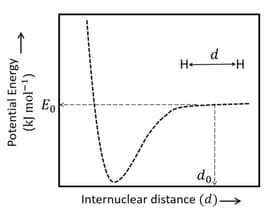What is ground state of an atom?
Important Questions on Structure of Atom
| List - I | List - II |
|---|---|
| (I) Radius of the orbit | |
| (II) Angular momentum of the electron in the orbit | |
| (III) Kinetic energy of the electron in the orbit | |
| (IV) Potential energy of the electron in the orbit | |
Which of the following options has the correct combination considering List-I and List-II?
| List - I | List - II |
|---|---|
| (I) Radius of the orbit | |
| (II) Angular momentum of the electron in the orbit | |
| (III) Kinetic energy of the electron in the orbit | |
| (IV) Potential energy of the electron in the orbit | |
Which of the following options has the correct combination considering List-I and List-II?
(Planck's constant, mass of electron charge of electron permittivity of vacuum, )
The figure below is the plot of potential energy versus internuclear distance of molecule in the electronic ground state. The value of the net potential energy (as indicated in the figure) is for at which the electron-electron repulsion and the nucleus-nucleus repulsion energies are absent, find the value of to the nearest integer value.
As reference, the potential energy of atom is taken as zero when its electron and the nucleus are infinitely far apart.
Use Avogadro constant as Give an answer to the nearest integer value.

The difference between the radii of and orbits of is . The difference between the radii of and orbits of is Ratio of is :
The correct statements among the following.
i.
ii. The maximum number of electrons in the shell with principal quantum number is equal to
iii. Extra stability of half-filled subshell is due to smaller exchange energy.
iv. Only two electrons, irrespective of their spin, may exist in the same orbital are.

